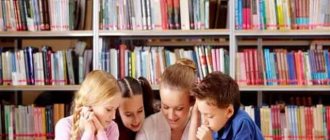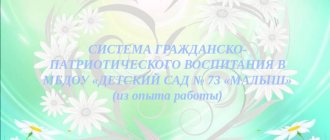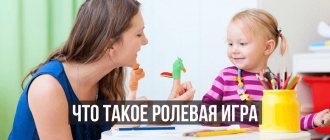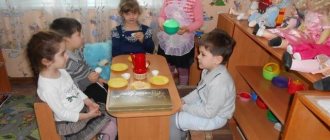Program “Plot-role play as a means of social and personal development of children”
12/05/2015 at 15:41
Ilita Abdulaevna, good evening. I carefully studied the presented program. I am always in favor of teachers themselves creating and presenting programs in various areas to the professional community so that other teachers can actively use them. This dissemination of experience also saves teachers time, so I support your initiative. I have some questions. which I would like, with your help, to remove. The PP lacks a normative and legal basis for drawing up a program. Here, you state that “the leading activity of preschool children is play, so recently the problem of introducing modern gaming technologies into educational practice has become the most pressing.” The very activity of this age category of children has obligated and obliges teachers at all times, and not just recently, to use gaming technologies. The next paragraph reads like this: “Playing out scenarios planned by the teacher or directly organizing and directing adult play actions is not a game and does not have a developmental effect.” And then the next paragraph: “Game management is one of the most difficult sections of preschool education methods...” I think the “play on words” needed to be addressed. But this is your opinion: “Secondly, the parents of modern children themselves belong to the non-playing generation, their childhood also passed without games, it was also full of educational elements..” confused me a little. If this is statistics, then there are no references to documents where this fact is reflected in the scientific literature. In the section “Novelty of the program” there is an interesting wording: “The program presents methods for activating parents in order to increase pedagogical competence in the development of role-playing games...”. Clarify please. Here is the “Expected Results” block. I think that the presented formulation is not professional: “The work system does not aim to achieve high results.” What is a system without goal-setting, because “The program “Plot-role-playing game as social and personal development of children” is an integral part of the educational plan of a preschool institution, part of the educational process”? The block “Factors for the success of program implementation” is interesting. But where is all this indicated, how to track the mandatory use of these factors? In paragraph 3.1 “Main directions of work with parents” the style suffers. And yet, a lot of water, repeated phrases from page to page. The program can be revised, optimized, filled with specificity and the result will be a wonderful guide to action. Good luck in the competition.
Appendix 3 (week 4)
Cognitive and research (constructive) activity - designing “What interesting things were remembered during excursions around the kindergarten” (construction of a hall and group).
Goal : To develop the ability to design buildings depending on their purpose.
Tasks:
- Learn to convey ideas in buildings.
- Teach children to build kindergarten premises.
- Develop the ability to come up with ways to design garden spaces so that everything stands firmly.
- Develop children’s own constructive ideas.
- Develop the ability to negotiate and build together.
- To instill in children respect for the work of adult builders who build socially significant objects for people.
Techniques:
- Conversation with children about the premises of the kindergarten.
- Joint discussion of the construction of premises. (Decision to build a group and a gym).
- Do you remember what equipment is in the hall?
- What furniture is in the group, what building material can be built from (table, chair, sofa, etc.)
- Children's contract on construction.
- Carrying out “construction work”.
- Help for children (verbal, effective).
- Result - what happened? Would you like to play around with this building?
- Was it difficult to carry out construction work using a wooden constructor?
- Invite children to play in the constructed premises.
Literature
- Dybina O.V. “Acquaintance with the subject and social environment” Moscow: “Mosaic-Synthesis”, 2014.
- Kutsakova L.V. “Labor education in kindergarten” Moscow: “Mosaika-Sintez”, 2014.
- Kutsakova L.V. “design from building materials” Moscow: “Mosaika-Sintez”, 2014.
- Yagodinsky V.N. “How to behave.” Moscow: “Knowledge”, 1991.
- Kupina N.A. "The ABCs of Behavior." Sverdlovsk: Ural University Publishing House, 1991.
- Lykova I.A. “Fine creativity in kindergarten” (Travel in slippers, felt boots, flippers, barefoot, on a flying carpet and in a time machine).
- Kazakova T.G. “Develop creativity in preschoolers” Moscow: “Enlightenment”, 1985.
- Krasnoshchekova N.V. “Plot-role-playing games for preschool children.” Rostov: “Phoenix”, 2007.
- The story of E. Permyak “How Masha became big.”
- Story by E. Permyak “The Worst Thing.”
- The story of E. Permyak “How Misha wanted to outwit his mother.”
- Yu. Yakovlev's story "The Sick"
- The story of Yu. Sinitsin “There is trouble with a man.”
- Story by I. Turichin “A Man Got Sick”
- The fairy tale “Doctor Aibolit” by K.I. Chukovsky.
- Poem by Z. Alexandrova “Katya in the manger”
- Poem “Kindergarten” (N. Yaroslavtsev)
- Poem “Preschool Children” (I. Gurina)
- Poem “Your Second Home” (G. Shalaeva)
- Poem “Kindergarten” (O. Vysotskaya)
- Poem “To kindergarten” (A. Vishnevskaya)
- Poem “Our beloved kindergarten” (E. Grudanov).
- Song "Kindergarten" lyrics by T. Volgina, music by A. Filippenko.
- Song “House with windows to childhood” (N. Agoshkova)
- Song “Kindergarten” (T. Kersten)
Go to the content of the short-term project “Our Favorite Kindergarten”
Appendix 2 (week 4)
Role-playing game “Kindergarten”
Purpose : To consolidate children’s knowledge about the work of a nurse, laundress, cook, janitor and other kindergarten workers.
Tasks :
- Development of the ability to apply acquired knowledge in collective creative
- game.
- Continue to teach children to distribute roles, agreeing and following
- the proposed plot.
- To develop the ability to creatively develop the plot of the game.
- Enrichment of vocabulary through words used in a situation
- communication with each other on the topic “Kindergarten”.
- Developing a sense of gratitude for the work adults do for them, a desire to provide
- help them as much as possible.
- Foster interest and respect for the work of kindergarten employees.
Techniques:
- Looking at illustrations about kindergarten.
- Tours of the kindergarten premises.
- Conversations “Who works in kindergarten and how”, “Maintaining a daily routine.”
- Didactic game “What do children do?”
- "Doll kindergarten"
- Reading poems about kindergarten.
- Individual orders.
- Duty roster.
- Joint play between children and the teacher (at first), assistance in assigning roles, tracking the storyline.
- In subsequent days, it is possible to combine 2 and 3 role-playing games “Hospital”, “Home”) with one plot.
During play, children imitate what they do in kindergarten (gymnastics, breakfast, washing, games, etc.)
Appendix 1 (week 4)
Getting to know the walking areas of different groups. Goal : to form children’s idea of kindergarten.
Continue to get acquainted with the territory of the kindergarten: the main building, walking and sports areas. Tasks :
- Teach children to navigate the territory of the kindergarten.
- Know the location of your site and the sites of other groups.
- Activate children's speech using words used in
- situations in which children communicate with each other.
- Develop memory and cognitive interests in children.
- Introduce children to the rules of communication and rules of conduct in
- in public places.
- To cultivate respect for the work of people who provide us with cleanliness and
- order in kindergarten.
Techniques:
- Conversation with the children about the fact that we will now go to visit the children of other groups.
- Clarify with your children the rules of behavior that they are already familiar with.
- At the site, say hello, ask permission from the teacher and children about
- to see the site and play together.
- Get to know the teacher and children.
- Offer to see what is on the playgrounds of different
- groups.
- Specify the name of metal structures and equipment, their
- location and color.
- Offer to play with the children of the group we came to
- guests.
- During the game, pay attention to friendly relations with each other
- with a friend, verbally reward for the help provided.
- At the end, thank the teacher and children for their hospitality and invite
- them to visit their site.
- At your site, talk about whether the children liked it? Do they want
- further communication with children of other groups? What do they like most?
- did you remember and like it?
The result is that we visited another group’s site, met the children, and played different games. We helped new friends, if our help was needed, we negotiated with them. We all had fun and interesting.
And so visit all areas of the kindergarten, getting to know the teachers, children, the name of the group and the location and equipment of the areas.





